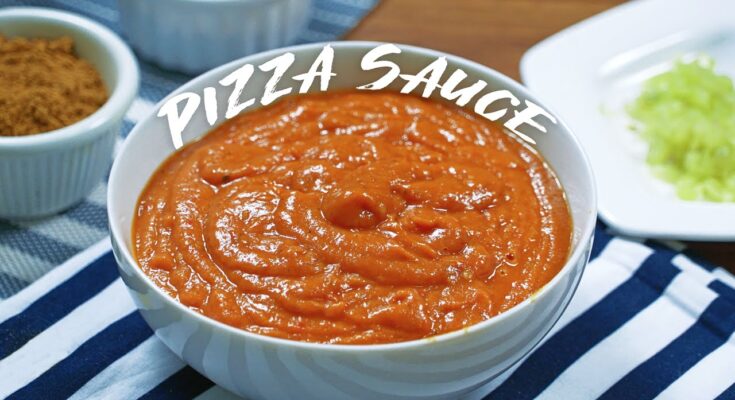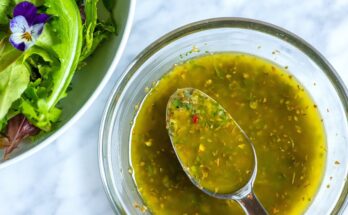Italian Pizza Sauce Recipe: Making authentic Italian pizza sauce at home is a total game-changer. It’s not just about the sauce—it’s about unlocking that bold, savory flavor that makes every bite of pizza a memorable experience. Whether you’re baking your pizza in a wood-fired oven or on a baking sheet in your kitchen, the sauce is what ties all the flavors together. And the best part? It’s incredibly simple to make with just a handful of ingredients.
Let’s be honest—store-bought sauces just don’t compare. They’re often loaded with preservatives, sugar, and weird ingredients you can’t pronounce. But this sauce? It’s pure, rich, and tastes like something straight out of an Italian pizzeria. This guide will walk you through everything you need—from the essential ingredients to every step of the cooking process—so you can create your very own perfect Italian pizza sauce at home.
Why Homemade Italian Pizza Sauce Is Better
If you’ve ever tasted a truly authentic homemade pizza sauce, you already know the magic. The depth of flavor, the fresh aroma of herbs, the richness of ripe tomatoes—it’s miles ahead of anything from a jar. First, you control the quality of ingredients. That means no high-fructose corn syrup, no artificial colors, no preservatives—just fresh, wholesome ingredients.
Also, homemade sauce is ridiculously cost-effective. For the price of one store-bought jar, you could probably make enough sauce for 4–5 pizzas. Plus, you can customize it however you like—spicy, herby, garlicky, or even slightly sweet.
And let’s not forget freshness. Using quality tomatoes and herbs makes a world of difference. When you simmer that sauce on the stove, your kitchen will smell like a rustic Italian trattoria. That alone is reason enough to make it from scratch.
What Makes Italian Pizza Sauce Unique
Italian pizza sauce is famous for its simplicity and purity. Unlike American-style sauces, it doesn’t try to overdo it with too many ingredients. The goal is to enhance—not overshadow—the taste of the pizza dough and cheese. You won’t find heavy sugar, artificial thickeners, or tons of spices in traditional Italian recipes.
What you will find is a balanced combination of tomatoes, garlic, olive oil, salt, and herbs. And that’s it! It’s the technique and the quality of ingredients that make it special.
Also, different regions in Italy have their own takes on pizza sauce. Naples, for example, prefers uncooked tomato sauce made from raw San Marzano tomatoes, while Rome might favor a slightly cooked version. Understanding these regional quirks helps you appreciate the sauce on a whole new level.
Ingredients You’ll Need
Here’s your master list of ingredients for the perfect Italian pizza sauce:
- Tomatoes (fresh or canned, preferably San Marzano or Roma)
- Extra virgin olive oil
- Fresh garlic (minced or finely chopped)
- Salt (preferably sea salt)
- Dried oregano
- Fresh or dried basil
- Black pepper
- A pinch of sugar (optional, to balance acidity)
If you like a slightly spicy or more complex sauce, consider adding:
- Crushed red pepper flakes
- A dash of balsamic vinegar
- A touch of onion (finely chopped)
- A splash of red wine (for depth)
Keep in mind: the best sauces come from minimalist ingredients used correctly. Don’t feel the need to throw everything in.
Optional Add-ons
Looking to experiment or dial up the flavor? Here are some extras you can try:
- Red wine: Adds depth and richness.
- Anchovy paste: Just a touch for an umami punch.
- Tomato paste: Helps thicken the sauce.
- Fresh parsley or thyme: Adds freshness.
- Grated Parmesan: Stir in a small amount for added umami.
Add-ons are great, butGrated Parmesan:** Stir in a small amount for added umami.
Add-ons are great, but keep it simple if you want to stay true to the Italian tradition.
Tools and Equipment Required
No need for fancy gadgets—just a few kitchen basics will do:
- Medium saucepan or skillet
- Wooden spoon or silicone spatula
- Garlic press or knife
- Blender (optional for smooth sauce)
- Storage jars or containers
- Knife and cutting board
If you have a food mill or immersion blender, you can also use those to get a smoother texture without over-blending.
Prepping Your Ingredients
Before you get cooking, let’s talk prep. The secret to smooth cooking is mise en place—everything in its place.
- Tomatoes: If using canned whole tomatoes, crush them by hand or with a spoon. If using fresh, blanch and peel them.
- Garlic and onions: Chop finely or mince for a uniform texture.
- Herbs: If using fresh herbs like basil or oregano, wash and chop them in advance.
- Olive oil: Choose a good-quality extra virgin olive oil. You’ll taste the difference.
Take your time with prep. Once you start cooking, the process moves quickly.
Step-by-Step Guide to Making Italian Pizza Sauce
Let’s get down to business. Here’s how to make authentic Italian pizza sauce from scratch.
Step 1: Heat the Olive Oil
Pour about 2–3 tablespoons of extra virgin olive oil into your saucepan. Heat on medium until shimmering—but not smoking.
Step 2: Sauté Garlic (and Onion, if using)
Toss in the garlic (and onion, if desired). Stir constantly for 30–60 seconds until fragrant. Be careful—burned garlic turns bitter.
Step 3: Add the Tomatoes
Add crushed tomatoes to the pan. Stir well to combine with the oil and garlic. If using whole canned tomatoes, crush them by hand before adding.
Step 4: Simmer
Bring the mixture to a light simmer. Let it cook uncovered on low to medium heat for about 20–30 minutes. This reduces the water content and deepens the flavor.
Step 5: Add Seasonings
Now’s the time to add salt, pepper, oregano, basil, and sugar (if needed). Stir gently and let simmer for another 10 minutes.
Step 6: Blend (Optional)
If you like a smoother sauce, use a blender or immersion blender to puree the sauce until it reaches your desired consistency.
Step 7: Final Touches
Taste your sauce. Adjust seasoning if needed. Want it spicier? Add some red pepper flakes. Need more depth? A splash of wine can do wonders.
The Secret to Perfect Consistency
Let’s be real—nobody wants a soggy pizza. The key to avoiding that dreaded sogginess lies in the consistency of your sauce. Your pizza sauce shouldn’t be watery, but it also shouldn’t be as thick as pasta sauce. So, how do you strike the perfect balance?
First, simmering is crucial. Give your sauce enough time on low heat so the water evaporates slowly and the flavors concentrate. It should coat the back of a spoon—thick enough to stay in place, but thin enough to spread easily.
Second, don’t over-blend. If you puree your sauce, pulse just a few times. Over-blending releases too much water from the tomatoes, and that can ruin the texture. A rustic, slightly chunky sauce actually works best for many Italian pizzas.
Lastly, if you’re in a hurry and need to thicken things up, you can stir in a small spoon of tomato paste, but use it sparingly. It can easily overpower the freshness of the sauce if you go overboard.
And here’s a little trick from Italian grandmothers—add a spoon of grated Parmesan cheese or a pinch of flour to thicken without compromising flavor. Just be sure to whisk it in evenly.
Raw vs. Cooked Pizza Sauce
Here’s where things get interesting. Did you know that many traditional Neapolitan pizzas use raw pizza sauce? That’s right—no simmering, no sautéing, just pure, crushed tomatoes seasoned with salt, olive oil, and herbs. The sauce cooks in the oven along with the pizza, maintaining that fresh, bright tomato flavor.
So, when should you use raw sauce vs. cooked?
Use raw sauce when:
- You’re making thin-crust Neapolitan-style pizza
- You’re using high-quality canned San Marzano tomatoes
- You want a bright, tangy, fresh tomato taste
Use cooked sauce when:
- You want a richer, more concentrated flavor
- You’re working with regular canned tomatoes or fresh tomatoes
- You like a thicker texture
Both are valid—and both are delicious—it just depends on your personal preference and the style of pizza you’re aiming for.
Tips for Storing Your Pizza Sauce
Made a big batch? Good! Pizza sauce stores beautifully, and having some on hand means you’re always just minutes away from homemade pizza night.
Refrigerator: Store your sauce in an airtight glass jar or container. It will last up to 5 days in the fridge. Just make sure to cool it completely before sealing it up.
Freezer: For longer storage, pour your sauce into freezer-safe bags or containers. Freeze in portions so you can just grab what you need later. It’ll stay good for up to 3 months in the freezer.
Pro tip: Ice cube trays are great for freezing small portions. Once frozen, pop them out and store them in a zip-lock bag. You’ll always have just the right amount when you need it.
Just remember to label the date—and try not to forget it’s there!
Best Types of Tomatoes for Pizza Sauce
Tomatoes are the heart and soul of Italian pizza sauce. Using the right kind can mean the difference between a good pizza and a phenomenal one.
- San Marzano tomatoes: These are the gold standard. Grown in volcanic soil near Mount Vesuvius, they’re naturally sweet, low in acidity, and incredibly flavorful. They’re also more fleshy, meaning less water and more tomato meat—ideal for pizza sauce.
- Roma tomatoes: Another solid choice, especially if you’re using fresh tomatoes. They’re easy to find and great for cooking due to their low moisture content.
- Canned whole tomatoes: If you can’t find fresh San Marzano, go for a high-quality canned version. Look for labels like “D.O.P.” or “certified” to ensure authenticity.
- Avoid pre-seasoned canned tomatoes: They often contain sugar and preservatives that will mess with the flavor of your homemade sauce.
If using fresh tomatoes, blanch and peel them before cooking. It’s a little extra work but totally worth it.
How to Use Italian Pizza Sauce
Now that you’ve got this amazing sauce, it’s time to put it to use! While pizza is the obvious choice, this versatile sauce can be used in so many delicious ways.
- Classic Neapolitan Pizza: Spread a thin layer of sauce on your pizza dough, add mozzarella and basil, then bake in a hot oven. Simple, yet heavenly.
- Deep Dish Pizza: Use a thicker layer of sauce and let it cook longer on top of the cheese for that rich, bold flavor.
- Flatbreads & Pita Pizzas: Quick, easy meals with a slather of sauce, cheese, and whatever toppings you love.
- Pizza Rolls & Calzones: The sauce works perfectly as both a filling and a dipping sauce.
- Pizza Toast: Great for kids (and grown-ups). Just toast a slice of bread, spoon on some sauce, add cheese, and broil until bubbly.
Don’t limit yourself—this sauce is more than just for pizza. It can go in pasta, be used as a dip, or even spooned over roasted veggies.
Common Mistakes to Avoid
Even with the best intentions, there are a few pitfalls that can mess up your pizza sauce game. Avoid these and you’re golden:
- Over-seasoning: Simplicity is key. Too much oregano or garlic can overwhelm the sauce.
- Using the wrong tomatoes: Choose ripe, flavorful, low-acid tomatoes like San Marzano or Roma. Skip the generic diced or pre-seasoned canned ones.
- Overcooking: Simmering too long can dull the flavor and darken the color. Keep it under 40 minutes max.
- Burning the garlic: Always sauté garlic on medium or low heat. Burnt garlic is bitter and will ruin the sauce.
- Making it too thick: Pizza sauce should be spreadable, not like tomato paste. If it’s too thick, add a splash of water or tomato juice.
- Adding too much sugar: Only use sugar if your tomatoes are very acidic. And only a pinch!
Serving Suggestions
Now for the fun part—eating! Here’s how to serve your Italian pizza sauce like a pro:
- Pair with fresh mozzarella and basil for a true Margherita experience
- Sprinkle with crushed chili flakes for a spicy kick
- Top with sliced olives, mushrooms, or anchovies for added umami
- Serve on the side as a dipping sauce for garlic bread or mozzarella sticks
- Drizzle a touch of olive oil over the sauce before baking for a glossy finish
Pair your pizza with a glass of Italian red wine and you’ve got yourself a restaurant-worthy meal at home.
FAQs about Italian Pizza Sauce Recipe
1. Can I freeze homemade pizza sauce?
Yes! Let it cool completely, then store it in freezer-safe containers or bags. It can last up to 3 months in the freezer without losing flavor.
2. What’s the difference between pizza and pasta sauce?
Pizza sauce is usually thicker, less sweet, and more concentrated. Pasta sauce often contains more herbs, sugar, and sometimes meat or vegetables.
3. Can I use fresh herbs instead of dried?
Absolutely. Fresh basil and oregano can make your sauce taste even better. Just use about 3 times more than the dried versions.
4. Is it okay to use canned tomato paste to thicken the sauce?
Yes, but use it sparingly. Tomato paste is intense and can overpower the sauce if overused. Just a spoonful is usually enough.
5. How do I thicken my pizza sauce naturally?
Simmer it on low heat uncovered for 20–30 minutes. This evaporates excess water and concentrates the flavor without any additives.
Conclusion
At the end of the day, making authentic Italian pizza sauce is about embracing simplicity and quality. It’s not about overloading your sauce with every herb and spice in the rack. It’s about letting a few great ingredients shine.
Once you make this sauce a few times, it becomes second nature. You’ll stop needing recipes and start trusting your senses—the look, the smell, the taste. And that’s when the magic really happens. So the next time you crave pizza, skip the jar and whip up your own sauce. Your taste buds will thank you, and you might just start a new tradition in your kitchen.



